The Effect of Various Classes of Malocclusions on the Maxillary Arch Forms and Dimensions in Jordanian Population- Juniper Publishers
JUNIPER PUBLISHERS-OPEN ACCESS JOURNAL OF DENTISTRY & ORAL HEALTH
The Effect of Various Classes of Malocclusions on the Maxillary Arch Forms and Dimensions in Jordanian Population- Juniper Publishers
Authored by Raghda Al Shammout
Abstract
Aim: The objective of this study
was to determine the differences of clinical maxillary arch forms in
Angle Class I, II, and III using arch dimension parameters.
Materials and method: A total
of 124 (76 females and 48 males) fully dentate Jordanian subjects (mean
age=18.34±4.26; range=14-22 years) were clinically examined and divided
into 3 groups according to Angle’s classifications (Class I, II and
III). Study casts were made and measured for 4 linear measurements of
maxillary cast dimensions were taken (Inter-canine and inter-molar
widths; and canine and molar depths). Canine W/D and molar W/D ratios
were calculated. Arch form was determined according to measurements and
related to occlusal pattern. The commonest malocclusion was class I
(54.8%), followed by class II (37.9%) and class III (7.3%).
Statistically significant differences were recorded in arch widths
(p<0.05); Class III maxillary dental arches (W=37.8mm) were narrower
than Class I (W=38.9 mm) and Class II dental arches (W=40.6mm) were the
widest. In Class I: 55% of arches were ovoid, 40% tapered and 5% square.
In Class II: 73% tapered 24% ovoid, and 3% square. In Class III: 45%
tapered, 35% ovoid and 20% square. Measurements were significantly
(p<0.05) higher in males than in females. No gender differences in
canine and molar W/D ratios were recorded. Although more males had Class
III, more females had Class II arches but the differences were not
significant.
Conclusion: Before orthodontic
treatment, the arch form should be determined in relation with patients’
occlusal pattern to achieve best esthetic, functional and stable arch
form out-come.
Keywords: Arch form; Angle’s classification; Malocclusion; Maxillary Arch; OrthodonticsIntroduction
The dental arch form is defined as the curving shape
formed by the configuration of the bony ridge [1]. Arch form, dimension
and variations obtained by orthodontic treatment has been studied for
many years by several authors [2-4]. Consideration of the arch form is
of paramount importance, because it is imperative that the arch form
should be examined before embarking upon the treatment as this gives
valuable information about the position into which teeth can be moved if
they are to be stable following treatment [5].
Different methods have been developed to describe the
dental arch morphology ranging from simple classification of arch shape
[6] through combinations of linear dimensions [7,8] to complex
mathematical equations [9,10].
In 1932, Chuck [11] classified the arch forms as
tapered, ovoid and square for the first time. These arch forms can also
be expressed as narrow, normal and wide [6]. Especially in determining
the arch wire forms utilized at the initial phase of the treatment, he
advocates that making a choice between these three forms would be better
than using a single arch form [7]. The arch form should be determined
in relation with each patients’ pre-treatment dental model and
especially in relation with each patients’ ethnic group in order to
achieve an esthetic, functional and stable arch form out-come [5,7].
Several researchers recognize that there is
variability in the size and shape of arch form in relation to Angle’s
classes of malocclusion [5,7,8,12-18]. In addition, the width, length
and depth of dental arches have had considerable implications in
orthodontic diagnosis and treatment planning in a modern dentistry based
on prevention and early diagnosis of oral disease [4,19-22].
Several researchers studied the mandibular arch
[5-8,14,18,22-25] while some others studied the maxillary arch
[2,13,21,26] however, many others studied both arches [1,3,4,
9-11,12,15-20,27-31].
With the availability of different preformed shapes and sizes
of arch wires, different studies highlighted the importance of
selection of patients clinical arch form and customization of arch
wire [5,8] in addition, determination of arch shape may be used
as a guide to fabricate customized arch wires, or even an entire
fixed orthodontic appliance system [29].
The importance of this study comes from the fact that
studies investigating the differences in the maxillary arch forms
in various types of Angle’s classes are scarce. Therefore, the
present study may serve as population study and a database
for future comparisons and to obtain baseline information
on the morphological arch dimensions of the fully dentate
population since these variations highly influence orthodontic
and prosthetic rehabilitation of patients.
The differences in various types of Angle’s classification
(Class I, II, and III) may cause changes in relation to the clinical
maxillary arch forms and variations in its dimension. Therefore, it
was hypothized that maxillary arch dimensions and morphology
is not affected by different types of Angle’s classes and between
genders.
Although there have been studies one on the evaluation of
arch forms in various groups, to the authors’ knowledge, no
such research has been performed on the Jordanian population;
thus this study aimed to determine the differences of clinical
maxillary arch forms in Angle Class I, II, and III in the Jordanian
population by identifying its morphological variations and to
evaluate gender differences with respect to arch dimension
parameters.
Materials and Method
A cross-sectional study of Jordanian males and females
who are fully dentate with different arch skeletal patterns, in
the City of Amman who attended the Orthodontic Clinic, Outpatients
Clinics, Department of Dentistry, Al-Hassan Hospital,
King Hussein Medical Center, Royal Medical Services. A random
sample for the study were selected from the general population,
who fulfilled objective diagnostic criteria and exposed to clinical
oral and dental examinations.
Ethical approval
FThe study was conducted for all patients who provided verbal
informed consent after it was approved by Head of the Dental
Specialities of the Department of Dentistry and The Human
Research Ethics Committee (No.1/2014 dated 6th January 2014)
at the Royal Medical services.
Inclusion/exclusion criteria
Subjects with different age groups who accepted to
participate were fully dentate with no dental anomaly and with no history of congenital abnormality, those who were not
exposed to any orthognathic surgical procedure, no missing
tooth/teeth and with no extensive restorative procedure (i.e.
crown and bridge work); and accepted to undergo clinical oral
and dental examination, were able to understand and agreed
with procedures carried out and used (such as taking alginate
maxillary impressions) in the study and who were willing to
accept the protocol and gave informed consent were included.
Exclusion criteria were subjects with history of orthognathic
surgery, missing teeth, crown and bridge work, removable
partial denture prostheses, as well as those who did not agree
to participate.
Participants
A total of 124 (76 females and 48 males) fully dentate
Jordanian subjects with mean age of 18.3±4.3 (ranged between
14 and 22) years; were clinically examined and divided into 3
groups according to Angle’s classifications (Class I, II and III).
All recruited patients were subjected to clinical examination,
a specially designed form concerning the patient’s demographic
data including age, gender, medical insurance number, occupation
and residence was filled by one of the authors.
Measurements
For each participant, alginate impression of the maxillary
arch was taken, and poured in dental stone to form a stone cast
(positive replica).
A stone cast was then made and marked with five reproducible
reference points (with a 2H pencil), these were: mid-mesioincisal
edges of central incisors, canine tips, mesiobuccal cusp tips of
the first permanent molars used to perform measuring four
linear measurements (Figure 1).

- Inter-canine width (ICW):The distance between right and left canines, measured from the tip of the canine tooth.
- Inter-molar width (IMW):The distance between the right and left first molars, measured from the highest point on the mesiobuccal cups of upper first molar tooth.
- Canine depth (CD):The shortest distance from a line connecting the canines to the origin between the central incisors.
- Molar depth (MD):The shortest distance from a line connecting the first molars to the origin between the central incisors.
Two proportional ratios were calculated:
- Canine Width/Depth (Wc/Dc) ratio:the ratio of the inter-canine width and the canine depth.
- Molar Width/Depth (Wm/Dm) ratio:the ratio of the inter-molar width and the molar depth.
All measurements were performed using Fowler electronic
digital caliper (Figure 2), the accuracy of the measurements was
set at ±0.01 mm.
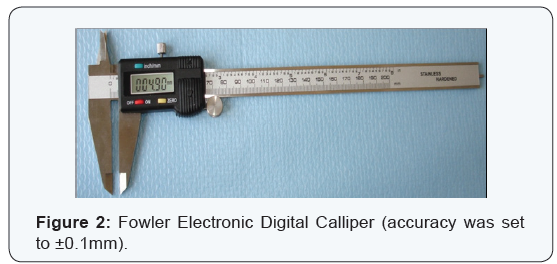
Arch form was determined mathematically according to a
formula [(Wc/Wm) / (Dc/Dm)] using the values obtained from
the measurements. The mean measured data on the maxillary
arch was used to determine the arch form and related to occlusal
pattern (Figure 3).
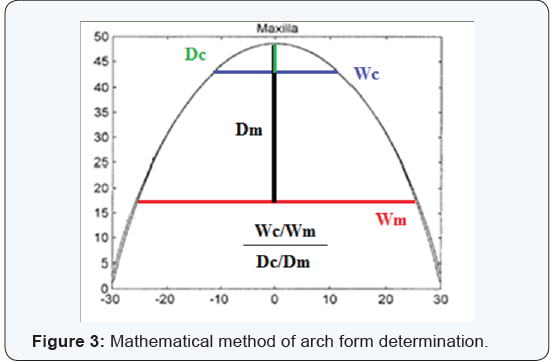
When the Wc/Wm ratio increases or the Dc/Dm ratio
decreases, the arch becomes squarer. On the contrary, when Wc/
Wm ratio decreases or Dc/Dm ratio increases, the arch gets a
more tapered form. Therefore, the formula is used to describe
the arch form.
When this ratio of a dental arch is within the range of mean±1
SD, we can assume the arch form is ovoid. However, when this
ratio for an arch form is more than mean+1 SD, we can consider
the arch form as square. Finally, when the ratio is less than mean
+1 SD, we can consider the arch form as tapered [9].
Methods error
Reliability of examiners was assessed by examining internal
consistency and reproducibility. Clinical examinations and
measurements were performed by two independent examiners
(66 subjects from one examiner and 58 from another examiner).
They used the same orthodontic evaluation in the clinical
examination for classifying occlusal relationship and standard
method in the measurements. Inter-examiner variability and bias
in evaluation were assessed by performing clinical examination
15 (12.1%) randomly selected subjects and re-measuring their
casts by each examiner. Student’s t-test were performed for
inter-examiner reliability evaluation.
Statistical analysis
Statistical analysis was performed using SPSS Statistic
Version 17 (SPSS Corporation, Chicago, IL, USA). Chi square and
Student’s t-test were used to compare the means of dimension
measured on the casts between different age groups and in
both genders. In addition, one-way ANOVA was used for the
comparisons between different arch forms and the skeletal
patterns. Ninety-five percent confidence intervals about the
mean were constructed for differences. Level of significance was
set at 0.05.
Results
Paired t-test revealed no statistically significant deviation
between the examiners’ clinical examination evaluation at a 5%
significance level (in 100%). Paired t-test revealed no statistically
significant deviation between the examiners’ measurements at a
5% significance level (mean difference 1.98±0.15; p=0.942). As
there was strong association and small mean difference between
the two examiners, it was assumed that the other data collected
from clinical examinations and measurement evaluations would
be reliable.
A total of 124 fully dentate Jordanian subjects with mean
age of 18.3±4.3 years (ranged between14 and 22) years. There
were 48 (38.7%) males with mean age 18.7±4.7 (ranged 15-22)
and 76 (61.3%) females with mean age 18.0±4.1 (ranged 14-
21) years. Females were slightly younger than males, but the
difference were not significant (t-test=0.47; p=0.95).
The commonest class was class I (54.8%), followed by class
II (37.9%) and class III (7.3%). Significantly, more females had
Class I (p<0.01) and Class II (p<0.05) occlusal relationship
compared with males. On the contrary, more males had Class
III relation compared with females but the differences were not
statistically significant (Table 1).

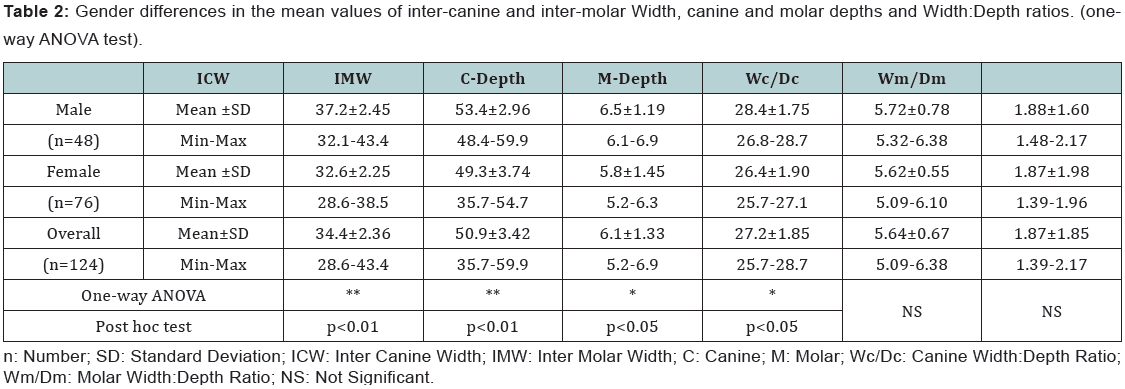
(Table 2) shows the gender differences in the mean canine and molar width and depth measurements and width: depth ratios. The mean values of all width and depth measurements were significantly (p<0.05) higher in males than in females. However, no gender differences in canine and molar W/D ratios were recorded. (Figure 4) shows the relationship between the mean values of inter-canine and inter-molar widths, canine and molar depths and W:D ratios with age. All width and depth measurements increased with age, inter-molar measurements recorded the steepest increase with age.
Statistically significant differences were recorded
in arch width measurements (p<0.05). Class III arches,
(Wc=33.7±2.7mm and Wm=49.5±4.1) are narrower than Class
I (Wc=34.3±2.1mm and Wm=50.2±3.6) (p<0.01) and Class II dental arches (Wc=34.8±2.5mm and Wm=52.1±2.8) are the
widest (p<0.05). However, there were no statistical significant
differences between different classes in depth and width: depth
ratios. (Table 3).
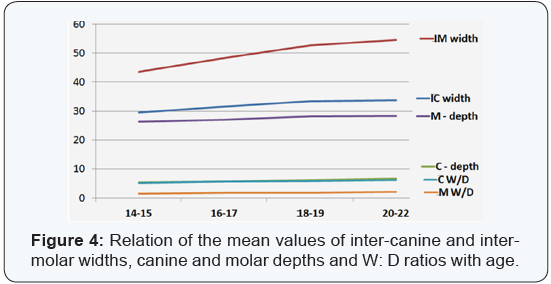
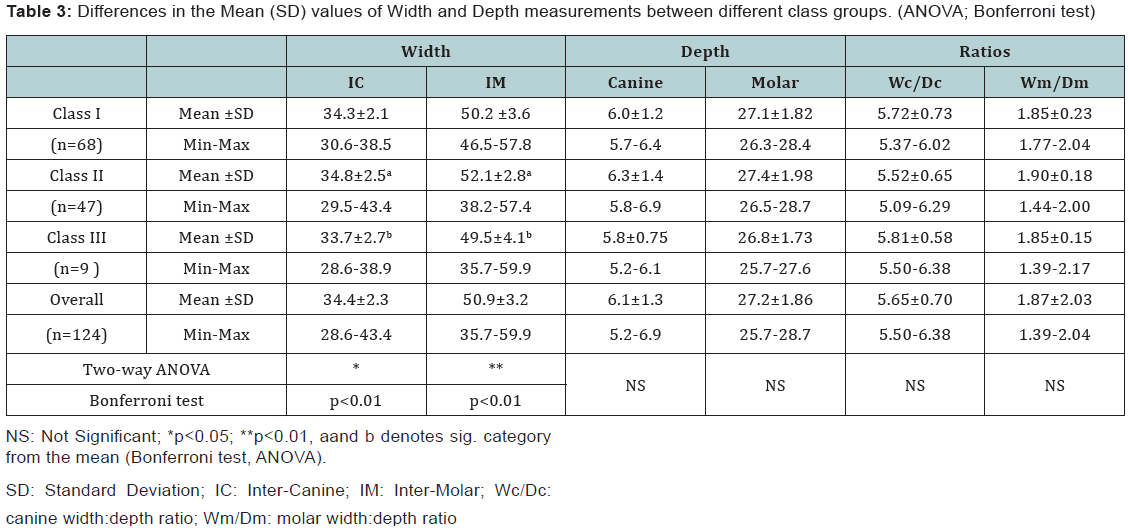
NS: Not Significant; *p<0.05; **p<0.01, aand b denotes sig. category
from the mean (Bonferroni test, ANOVA).
SD: Standard Deviation; IC: Inter-Canine; IM: Inter-Molar; Wc/Dc:
canine width:depth ratio; Wm/Dm: molar width:depth ratio
(Table 4) shows the distribution of participants’ arch form
(square, tapered and ovoid) according to Angle’s classification.
Analyses of data according to the mathematical formula show
that 52.4% of subjects have tapered maxillary arches and 41.1%
ovoid. However, the least common arch form is the square which
is recorded in only 6.5%. The commonest arch form in class I was
the ovoid followed by tapered, however, in class II and class III
subjects, the commonest arches were tapered.

Discussion
This study was conducted to determine the differences of
clinical maxillary arch forms in Angle Class I, II, and III using
arch dimension parameters, the sample was representative of a
group of Jordanian population of dental patients that attended
conservative and orthodontic dental clinics for a period of 6
months.
The size and shape of the dental arches have considerable
implications for orthodontic diagnosis and treatment planning.
These have an effect on the space availability, stability of
dentition, esthetics and health of the periodontium [5].
In this study, more than 60% of the participants were women,
although there was no statistically significant difference in the
mean age between genders, women were slightly younger than
men. In addition, the age distribution was limited with 14-22 in
order to eliminate the variations in arch dimensions related with
age. In addition, the age-related changes in the mean values of
inter-canine and inter-molar width and depth measurements
and W: D ratios shows a little gradual increase with age, however,
the inter-molar measurements recorded the steepest increase
with age.
After examining the differences in arch width in relationship
with age, Bishara et al. [32] stated that although they had
observed a reduction in canine width between 13-26 and 26-
45 in men and women, only the reduction detected in women
between 26-45 was statistically important. Even though there
is an increase in mandibular canine width until 13 years; this
increase is found to be statistically important in boys until 8 and
in girls until 13 years of age. After 13 years of age, the canine
width shows a reduction in 25 and 45 years. In Bishara’s study
the inter-molar width did not show a significant change between
13-26 and 26-45 years.
In the present study, gender-related differences were
recorded in all arch width and depth measurements. When
comparing arch dimensions with regard to gender, it was found
that they are remarkably higher in males than females. These
findings are in accordance with a previous study [33]. In an evaluation of arch width and depth measurements, it has been
reported that these values are 3%-5% higher in boys [27]. It has
been stated that the arch depth decreases in canine, first and
second premolar and first molar teeth area in both genders [34].
The results that showed no differences in boys and girls were
reported previously [18]. In most of the studies, although the
values are less in girls, there is a relationship with the gender
and arch dimension of the samples. It was postulated that there
were significant differences related with gender only in the
transversal dimensions [35]. In present study even though there
are significant differences with respect to gender and canine/
molar width, both of the measurements are found to be higher in
boys. Although boys possess a wider arch form than girls, there
is an overall agreement that there is no gender variance with
respect to arch form [36]. As it can be derived from these results,
no statistically significant variances were found between gender
and arch form.
The results of this study demonstrated that 54.8% of subjects
were class I, 37.9% class II and the least (7.3%) were class III.
In addition, significantly, more females had Class I and Class II
occlusal relationship compared with males. On the contrary,
more males had Class III relation compared with females but the
differences were insignificant.
Similar findings were reported by Murshid [8] who found
that class I was most prevalent (58.2%), followed by class II
(32.7%) and class III (5.7%), in addition, it was reported that
58% were class I, 40% were class II and only 2% were class III
[18]. However, Tajic et al. [5] reported that class II was the most
prevalent (47.5%) followed by class I (45.8%) and the least was
class III (6.7%). These differences could be attributed to racial
variation in study samples.
Upon examination of the arch dimension differences between
Angle classes, this study revealed statistically significant
differences between classes in terms of arch width measurements
(p<0.05). Class III arches were significantly narrower than Class I
(p<0.01) and Class II dental arches were significantly the widest
(p<0.05). However, the differences between different classes in
depth and width: depth ratios were insignificant.
The molar width increase in Class II arches can be explained
by buccal tipping of the anterior teeth in Class II development
and flattening of the anterior area besides the lateral growth of
the tongue due to the decrease of the molar depth [13,14]. In our
study, when maxillary canine and molar depths were considered,
no difference could be detected between Class I, II and Class
III, also, upon comparison of these groups together in terms of
width-depth ratios, no statistically significant differences were
observed.
Arch shapes may also define characteristics of a particular
occlusion group. Othman et al. [31] used tapered, square and
ovoid arch form templates to evaluate the arch forms of angle
class I, II and III. In this study, analyses of data according to the
mathematical formula show that 52.4% of subjects have tapered
maxillary arches and 41.1% ovoid. However, the least common
arch form is the square which is recorded in only 6.5%. The
findings of this study were similar to that reported in previous
studies [7,12].
When comparing the arch form (square, tapered and ovoid)
according to different classes, the commonest arch form in class
I was the ovoid followed by tapered, however, in class II and class
III subjects, the commonest arches were tapered. These findings
strongly suggested that ovoid form should be considered when
dealing with Class I cases and tapered form when Class II and
III. The findings of this study are supported by the following
previous studies [8,13,18].
The aim in specification of the arch form was to evaluate
the final arch form which will be obtained by the use of fixed
orthodontic appliances in patients who have referred to
orthodontic clinic due to orthodontic malocclusion. In recent
studies this arch form which is thought to be more realistic is
preferred in determining the individual arch form [9,14].
Several studies used arch form templates for the evaluation
of photo-copies of dental models, these are the 3 type of
(narrow, normal and wide) arch forms specified by Paranhos
et al. [6] and used by Chuck [11] for the first time in 1932. In
this study, however, the maxillary arch form was determined
mathematically using the values of width and depth obtained
from the measurements [9,13].
The importance of this study is that determination of arch
form in relation to different occlusal pattern is a prerequisite
to orthodontic treatment in order to obtain the best outcome.
As far as, esthetics is concerned, tapered arch form presents a
better smile arc than square arch form which tends to provide
a flatter smile arc which is not esthetically pleasing [37]. Space
availability and stability of dentition are the factors of particular
significance especially in a tapered arch group as the intercanine
width is the shortest comparing the ovoid and square variety.
Any arch expansion in the tapered arch group is deleterious for
proper alignment of the lower labial segment since this region is
constrained by circumoral musculature [5].
The differences in the various types of malocclusions (Angle
Class I, II and III) may affect the maxillary arch form and in the
distribution of morphological arch dimension. The present study
that provides information concerning the differences of clinical
maxillary arch forms in Angle Class I, II, and III demonstrates a
baseline knowledge by identifying its morphological variations
and evaluating gender differences with respect to arch dimension
parameters Jordan refutes the null hypothesis./p>
Although many researchers studied the differences in the
maxillary arch forms in various types of occlusal patterns, but it
was difficult to compare their results with ours due to variations
in the variables incorporated and racial differences.
One of the limitation of this study was small sample size
and limited participation rate, thus it does not represent
Jordanian population as a whole. In addition, the method used
gives information about arch form mathematically ignored the
perceived personal judgment, thus other methods to determine
arch form was not considered. Another disadvantage was that
the mandibular arch form was not considered.
Therefore, further research is still needed to overcome the
limitations of this study which includes studying a larger sample
and including other methods of arch form determination,
different age groups and incorporation of mandibular arch form
may be needed before the results of this study can be applied on
the general population.
Conclusion
Within the limitations of this study and due to the lack of
studies aimed at maxillary arch form variances in Jordan, the
following conclusions can be withdrawn:
- The commonest class was class I (54.8%), followed by class II (37.9%) and class III (7.3%). Significantly, more females had Class I (p<0.01) and Class II (p<0.05) occlusal relationship compared with males.
- The mean values of all width and depth measurements increased with age and were significantly (p<0.05) higher in males than in females.
- Significantly, class III arches are narrower than class I (p<0.01) and class II arches are the widest (p<0.05).
- The most frequently seen arch form was the tapered (52.4%) and ovoid (41.1%)., the least frequent one was the quare one which is recorded in only 6.5%.
- The commonest arch form in class I was the ovoid followed by tapered, however, in class II and class III subjects, the commonest arches were tapered.
With this study, it is foreseen that the arch form should
be determined in relation with each patients’ pre-treatment
maxillary dental model in order to achieve the best esthetic,
functional and stable arch form out-come.
For more Open Access Journals in Juniper Publishers please
click on: https://juniperpublishers.com
For more articles
in Open Access Journal of Dentistry & Oral Health please click on:

Comments
Post a Comment